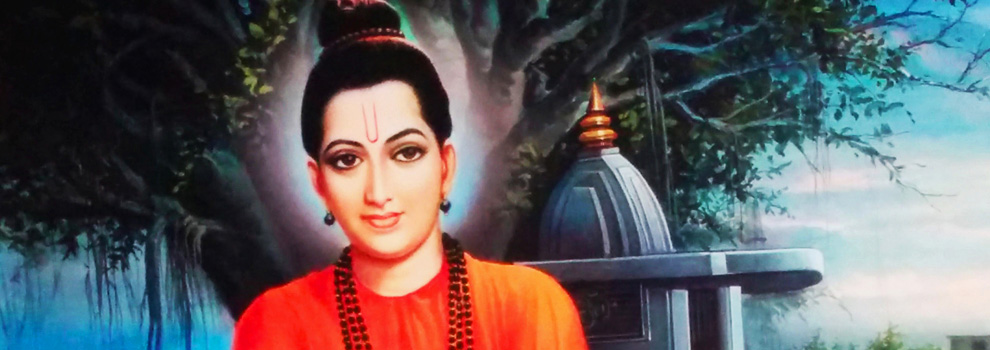Further Incarnations: Narasimha Saraswati
“I will incarnate whenever dharma touches bottom most level.”
- Srīpāda
Overview Incarnations
more about Narasimha Saraswati
Impressions of Narasimha Saraswati
Continue: Swamī Samartha
 In his life as Srīpāda Srīvallabha, he had already announced: “To revive the ascetic way of life, I will take birth as Narasimha Saraswati and remain in that incarnation for 80 years.“
In his life as Srīpāda Srīvallabha, he had already announced: “To revive the ascetic way of life, I will take birth as Narasimha Saraswati and remain in that incarnation for 80 years.“
He declared that as Narasimha Saraswati he will display many miracles in Gandharvanagar, Karnataka, and that he will withdraw at the end of that incarnation to Kadali Vanam to remain in meditation for 300 years. He even told an ascetic who seemed to be a mad monk but who in truth was a highly evolved soul: “You will be born as Krishna Saraswati, as the third one in the lineage of your disciples. You will have lot of fatherly affection towards me. Therefore, when I incarnate again as Narasimha Saraswati you will initiate me into the ascetic order as my preceptor, Srī Krishna Saraswati in Kasi.” He also informed other persons in his surroundings that they would reincarnate and meet him in his future incarnation.
The details about the life of Narasimha Saraswati (also spelled Nrusimha Saraswati, 1378-1459) are known from one source only, the Srī Guru Charitra. The book was written around 1450 in the form of a conversation between Siddha Saraswathi, a close disciple of Narasimha Saraswati, and his disciple Nāmdharak. Five of a total of fifty two chapters in this book give some details of the life of Srīpāda and the other parts describe the life and teachings of Narasimha Saraswati.
Narasimha Saraswati took birth in a Brahmin family in Karanjapur (today Karanja Lad) in Maharashtra. His father’s name was Madhav and his mother’s name was Amba Bhavani. In her previous life as Ambika, Srīpāda had saved her from committing suicide and told her that he would be born as her son in her ensuing birth (Srīpāda Srīvallabha Charitāmrutam, chapter 4). In the life of Narasimha Saraswati, he revealed to his mother her previous birth at the time of his leaving home and blessed her with the vision of his divine form.
The name given to the newborn child was Shaligramdev but his pet name was Narahari; his surname was Kale. “Shaligrama” or “salagrama” is a stone regarded as a symbol of the universal god. “Nara” means the eternal, divine part of man, a descendent of Narayana, the source of all beings. “Hari” is a name of the Lord as the Descended One. So his name denotes the descent of the divine.
The first word the boy uttered after birth was OM but thereafter he did not speak. His parents were worried about his speaking abilities. However, he showed with his hands that he was able to speak. After he received the initiation into Gayatri (upanayanam) at the age of seven he began to speak. It was a great surprise that he immediately started giving lectures on the Vedas. Senior Brahmins of the village soon came to him for learning.
In 1386, at the age of eight, he left home alone and went on a pilgrimage to Kashi (Varanasi). There he was admitted into the Swamī order by Srī Krishna Saraswati, who gave him the name Srī Narasimha Saraswati. Narasimha is the name of the Man-Lion incarnation of Vishnu, and Saraswati the name of the goddess of Wisdom. Later the young ascetic wandered around visiting holy places for about eighteen years and then returned to his hometown to meet his parents. In 1418, he continued his pilgrimage to holy places before he finally settled in Gandharvanagar (the City of Ganagapura in Karnataka) in 1435. He stayed there for twenty years until he disappeared in 1459. He withdrew to Kadali Vanam, a banana forest near Srīsailam, Andhra Pradesh. He stayed there doing penance for 300 years before he reappeared as Swamī Samartha.
Many supernatural events happened around Narasimha. One of them was the miraculous healing of the Sultan of Bidar, who was suffering from a blister which no one could heal. After visiting Narasimha the king was cured.
Continue: Swamī Samartha
Sources:
- Shirdi Sai Parivaar, Milpitas, California, U.S.A.: Guru Charitra (PDF)
- Sree Datta Vaibhavam: Sree Nrusimha Saraswati Swamy
- Agni Hotra – Healing Fire: Shri Nrusimha Saraswati
- Shankar Bhatt: Srīpāda Srīvallabha Charitāmrutam







